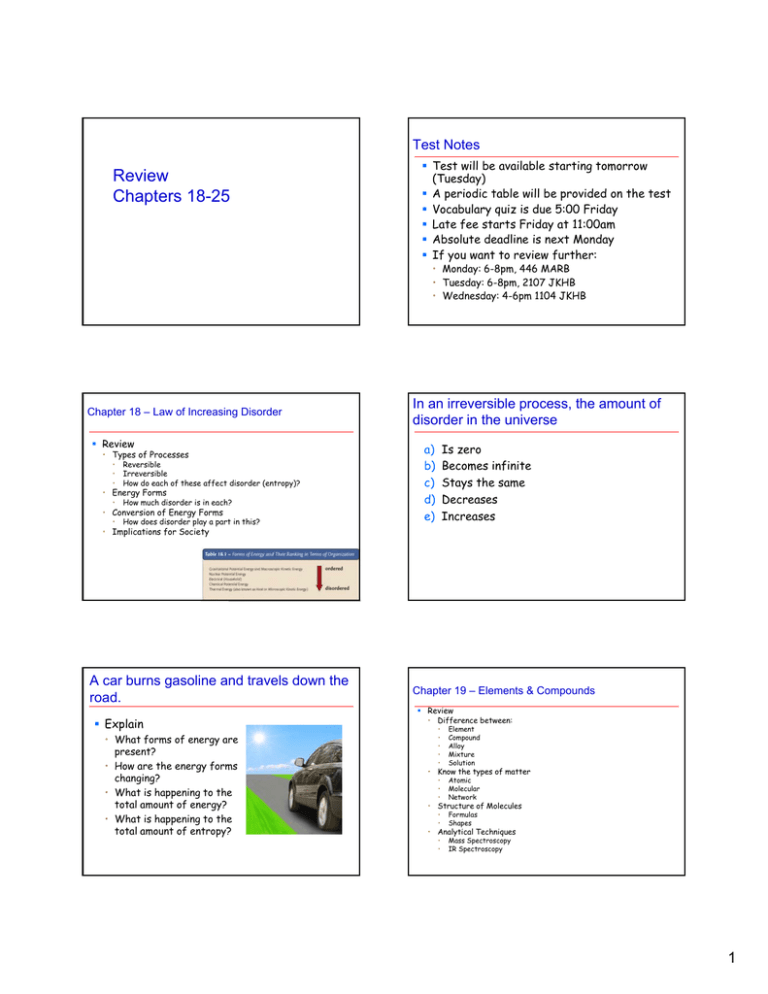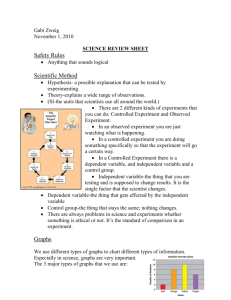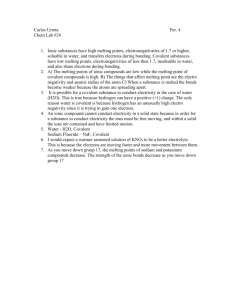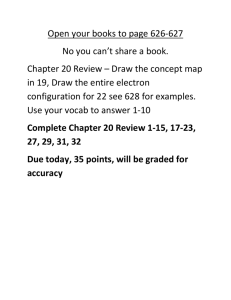Review Chapters 18-25 Test Notes
advertisement

Test Notes Review Chapters 18-25 Test will be available starting tomorrow (Tuesday) A periodic table will be provided on the test Vocabulary quiz is due 5:00 Friday Late L t fee f starts t t F Friday id att 11:00am 11 00 Absolute deadline is next Monday If you want to review further: • Monday: 6-8pm, 446 MARB • Tuesday: 6-8pm, 2107 JKHB • Wednesday: 4-6pm 1104 JKHB Chapter 18 – Law of Increasing Disorder Review • Types of Processes • Reversible • Irreversible • How do each of these affect disorder (entropy)? • Energy gy Forms • How much disorder is in each? • Conversion of Energy Forms • How does disorder play a part in this? In an irreversible process, the amount of disorder in the universe a) b) c) d) e) Is zero Becomes infinite Stays the same D Decreases Increases • Implications for Society A car burns gasoline and travels down the road. Explain • What forms of energy are present? • How are the energy gy forms changing? • What is happening to the total amount of energy? • What is happening to the total amount of entropy? Chapter 19 – Elements & Compounds Review • Difference between: • • • • • Element Compound Alloy Mixture Solution • • • Atomic Molecular Network • • Formulas Shapes • • Mass Spectroscopy IR Spectroscopy • Know the types of matter • Structure of Molecules • Analytical Techniques 1 Which of the following is a type of network matter? A. B. C C. D. E. Which of the following elements is most likely to form an alloy with gold (Au)? A. B. C. D. E E. Hydrogen gas Water C b n di Carbon dioxide xid Sodium Chloride Methane What would the formula be for propanol, the next member of this molecular family? Ag (Silver) Si (Silicon) O (Oxygen) F (Fluorine) B (Boron) Chapter 20 – Chemical Reactivity Review • Chemical Bonding Methanol • New orbitals • Importance of valence electrons Ethanol • Balancing Equations A. B. C. D. CH3OH C2H5OH C3H7OH C7H9OH • Conservation of Matter & Charge • Rates of Chemical Reactions Propanol A combination of Ca and Cl would result in which type of matter a) b) c) d) Molecular Atomic Alloy N t Network kS Solid lid • Activation Energy • Entropy • Catalysts • Chemical Equilibrium Which of the following equations is balanced? A. B. C C. D. E. CH4 + O2 = CO2 + H2O CH4 + 2O2 = CO2 + 2H2O 2CH4 + O2 = 2CO2 + H2O CH4 + O2 = CO2 + H2 CH4 + O2 = C2H6 + H2O 2 Chapter 21 – Bonding of Metals Review • Properties of Metals • What are the electron orbitals like? • • • Include huge numbers of atoms Lots of energy levels (band) Electrons free to move • • • • • • • Opaque Conductors of heat & electricity Shiny, reflective Chemically reactive Malleable and Ductile High Melting Temperature Alloys • How are they different from metals • How does this explain the properties of metals? An LED made with a semi-conductor emits red light. If the LED is heated, however, the electron band gap decreases. How will this affect the color of the light emitted? A. Shift it to longer wavelength light B. Shift to shorter wavelength light C No C. N effect ff t will ill b be observed on the light emitted • Semi-conductors Chapter 22 – Ionic Bonding How many electrons does nitrogen (N) have in its outermost s and p orbitals? Review • Properties of Ionic Materials • Why does the bond form A. B. C C. D. E. • Valence electrons • Electromagnetic attraction • Characteristics of Bond • Electrons localized near atoms • Not free to move • Few electron energy levels • How does this explain… • • • • 1 2 3 4 5 High melting and boiling T Transparency Brittleness Electrical properties Which of the equations below for the ionic compound potassium oxide is balanced? A. B. C. D. K + O2 = KO2 K + O2 = K2O 4 + O2 = 2K2O 4K 2K + O2 = KO2 Compare and Contrast: Ionic Compounds vs Metals Network Solids High melting T’s Brittle solids Don’t conduct heat and electricity in solid Often colorless and usually transparent in big chunks (White when powdered) Network Solids High melting T’s Malleable Good conductors of heat and electricity in solid Opaque 3 Which of the following will not be a property of potassium oxide? Chapter 23 – Covalent Bonding Review • Properties? A. B. C.. D. E. High melting and boiling T White when powdered Conduct onduct electricity electr c ty when solid sol d Dissolve in water Brittle • Melting and Boiling T’s • Electrical conductivity? • How does a covalent bond form? • Sharing of valence electrons • Polar Bonds/Non-polar Bonds • Electronegativity • Polar & Non-polar Molecules • Types of Intermolecular forces • Dispersion • Dipole-dipole interactions • Hydrogen Bond • Covalent materials properties Which of the following atoms would likely be the most electronegative? A. B. C C. D. C N O F Chapter 24 – It’s All Chemistry Which covalent materials dissolve most readily in water? A. Those with strongly polar molecules B. Those with weakly polar molecules C. Those without polar molecules D. This property has nothing to do with the polar nature of the molecules Which of the fatty acids shown would have the lowest melting temperature? Review • Fatty Acids • • • • Saturated Fats Unsaturated Fats Trans Fats How do the molecule’s shapes affect properties? A B • Silicate Minerals • What is the basic unit that forms these minerals? • How can it be put together? • How does the internal structure affect the external properties? 4 The fatty acid shown below has one double bond between carbon atoms, but is not kinked. This would be classified as…? A. B. C C. A saturated fatty acid A poly-unsaturated fatty acid A trans-fatty trans fatty acid Chapter 25 – Nuclear Processes Review • Properties of the strong force • Nuclear Potential Energy • How does it relate to mass per nucleon? • How H d does an atom t gain i it or llose it? • Fusion • Which atoms are likely to fuse? • Fission • Which atoms are likely to fission? • Why? • Radioactive Decay • Why does it happen? Fission and Fusion Is it Fission or Fusion: Which is a splitting apart? Which is a welding together? Which requires enormous temperatures (100,000,000 degrees Celsius)? Which uses isotopes of hydrogen? Which uses isotopes of uranium? Which can release energy explosively (bombs)? Which is presently used as a commercial source of energy? Which powers the sun? Which produces very long-lived (250,000 years) radioactive by-products? Electron-positron annihilation is classified as which? Which is the more easily controlled? Which promises the more plentiful, more easily obtained ingredients for fuel? A sample of radioactive material with a half-life of 6 hours sits for a day (24 hrs). How much of the original material remains? a) b) c) d) A half A quarter An eighth A sixteenth i t th 5






